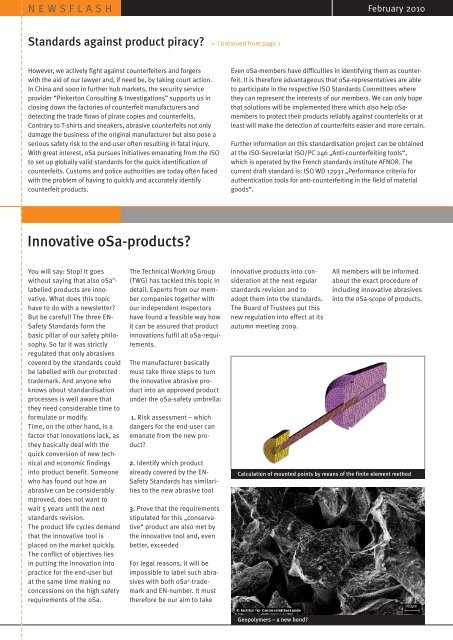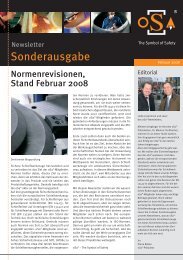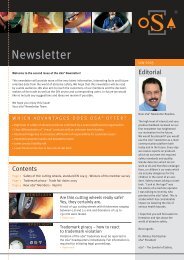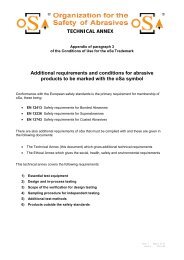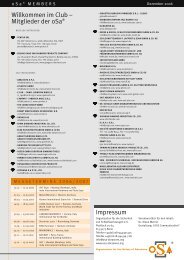7. oSa Newsletter - Organisation für die Sicherheit von ...
7. oSa Newsletter - Organisation für die Sicherheit von ...
7. oSa Newsletter - Organisation für die Sicherheit von ...
Create successful ePaper yourself
Turn your PDF publications into a flip-book with our unique Google optimized e-Paper software.
N E W S F L A S H<br />
February 2010<br />
Standards against product piracy? • Continued from page 1<br />
However, we actively fight against counterfeiters and forgers<br />
with the aid of our lawyer and, if need be, by taking court action.<br />
In China and soon in further hub markets, the security service<br />
provider “Pinkerton Consulting & Investigations” supports us in<br />
closing down the factories of counterfeit manufacturers and<br />
detecting the trade flows of pirate copies and counterfeits.<br />
Contrary to T-shirts and sneakers, abrasive counterfeits not only<br />
damage the business of the original manufacturer but also pose a<br />
serious safety risk to the end-user often resulting in fatal injury.<br />
With great interest, <strong>oSa</strong> pursues initiatives emanating from the ISO<br />
to set up globally valid standards for the quick identification of<br />
counterfeits. Customs and police authorities are today often faced<br />
with the problem of having to quickly and accurately identify<br />
counterfeit products.<br />
Even <strong>oSa</strong>-members have difficulties in identifying them as counterfeit.<br />
It is therefore advantageous that <strong>oSa</strong>-representatives are able<br />
to participate in the respective ISO Standards Committees where<br />
they can represent the interests of our members. We can only hope<br />
that solutions will be implemented there which also help <strong>oSa</strong>members<br />
to protect their products reliably against counterfeits or at<br />
least will make the detection of counterfeits easier and more certain.<br />
Further information on this standardisation project can be obtained<br />
at the ISO-Secretariat ISO/PC 246 „Anti-counterfeiting tools“,<br />
which is operated by the French standards institute AFNOR. The<br />
current draft standard is: ISO WD 12931 „Performance criteria for<br />
authentication tools for anti-counterfeiting in the field of material<br />
goods“.<br />
Innovative <strong>oSa</strong>-products?<br />
You will say: Stop! It goes<br />
without saying that also <strong>oSa</strong> ® -<br />
labelled products are innovative.<br />
What does this topic<br />
have to do with a newsletter?<br />
But be careful! The three EN-<br />
Safety Standards form the<br />
basic pillar of our safety philosophy.<br />
So far it was strictly<br />
regulated that only abrasives<br />
covered by the standards could<br />
be labelled with our protected<br />
trademark. And anyone who<br />
knows about standardisation<br />
processes is well aware that<br />
they need considerable time to<br />
formulate or modify.<br />
Time, on the other hand, is a<br />
factor that innovations lack, as<br />
they basically deal with the<br />
quick conversion of new technical<br />
and economic findings<br />
into product benefit. Someone<br />
who has found out how an<br />
abrasive can be considerably<br />
mproved, does not want to<br />
wait 5 years until the next<br />
standards revision.<br />
The product life cycles demand<br />
that the innovative tool is<br />
placed on the market quickly.<br />
The conflict of objectives lies<br />
in putting the innovation into<br />
practice for the end-user but<br />
at the same time making no<br />
concessions on the high safety<br />
requirements of the <strong>oSa</strong>.<br />
The Technical Working Group<br />
(TWG) has tackled this topic in<br />
detail. Experts from our member<br />
companies together with<br />
our independent inspectors<br />
have found a feasible way how<br />
it can be assured that product<br />
innovations fulfil all <strong>oSa</strong>-requirements.<br />
The manufacturer basically<br />
must take three steps to turn<br />
the innovative abrasive product<br />
into an approved product<br />
under the <strong>oSa</strong>-safety umbrella:<br />
1. Risk assessment – which<br />
dangers for the end-user can<br />
emanate from the new product?<br />
2. Identify which product<br />
already covered by the EN-<br />
Safety Standards has similarities<br />
to the new abrasive tool<br />
3. Prove that the requirements<br />
stipulated for this „conservative“<br />
product are also met by<br />
the innovative tool and, even<br />
better, exceeded<br />
For legal reasons, it will be<br />
impossible to label such abrasives<br />
with both <strong>oSa</strong> ® -trademark<br />
and EN-number. It must<br />
therefore be our aim to take<br />
innovative products into consideration<br />
at the next regular<br />
standards revision and to<br />
adopt them into the standards.<br />
The Board of Trustees put this<br />
new regulation into effect at its<br />
autumn meeting 2009.<br />
All members will be informed<br />
about the exact procedure of<br />
including innovative abrasives<br />
into the <strong>oSa</strong>-scope of products.<br />
Calculation of mounted points by means of the finite element method<br />
Geopolymers – a new bond?


